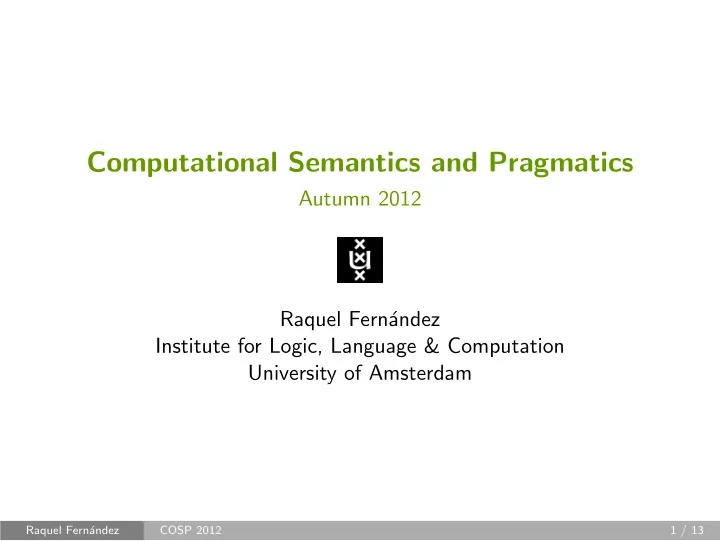

Computational Semantics and Pragmatics Autumn 2012 Raquel Fernández Institute for Logic, Language & Computation University of Amsterdam Raquel Fernández COSP 2012 1 / 13
Plan for Today Wrapping up our first topic: computational formal semantics • the Functional Programming approach • other approaches and available resources What’s next? • Lexical semantics Raquel Fernández COSP 2012 2 / 13
Computational Formal Semantics Modelling the semantics of a fragment of Natural Language à la Montague: • Meaning representations: formal language, e.g. FOL Why? ∗ unambiguous ∗ model-theoretical interpretation ∗ reasoning • Principle of compositionality ∗ meaning of non-sentential components: lambda expressions ∗ semantic composition: functional application • Syntax-driven semantic composition ∗ input: a parse tree (given a grammar and a parser) ∗ output: a logical formula ◮ whose truth can be evaluated on a model (of a situation/the world) ◮ which can be used for reasoning ⇒ HW#2 Raquel Fernández COSP 2012 3 / 13
Computational Semantics with FP Haskell is particularly well suited to implement compositional formal semantics: • based on the typed lambda calculus (like Montague grammar) • FP implementations are very close to formal definitions • declarative Raquel Fernández COSP 2012 4 / 13
Other Approaches Other implemented approaches to computational formal semantics: • Patrick Blackburn & Johan Bos http://www.blackburnbos.org Representation and Inference for a Natural Language ∗ Prolog implementation • Steven Bird, Ewan Klein, and Edward Loper http://nltk.org Natural Language Processing with Python ∗ Python implementation ∗ Chapter 10: Analyzing the Meaning of Sentences An advantage of these approaches is that they come together with extra NLP tools and resources over and above semantic processing. Raquel Fernández COSP 2012 5 / 13
C&C Tools Johan Bos’ approach to computational semantics has been included into the so-called C&C Tools by James Currant and Stephen Clark http://svn.ask.it.usyd.edu.au/trac/candc ֒ → efficient and robust tools for large-scale NLP tasks With regards to semantic composition, the key ingredients are: • CCG: Combinatory Categorial Grammar • Boxer: DRT-based semantic analyzer Johan Bos (2008) Wide-Coverage Semantic Analysis with Boxer. In: J. Bos, R. Delmonte (eds): Semantics in Text Processing. STEP 2008 Conference Proc. , pp.277–286, Research in Computational Semantics, College Publications. Raquel Fernández COSP 2012 6 / 13
Basics of CCG The CCG site http://groups.inf.ed.ac.uk/ccg/ Grammatical entities are associated with either a basic or a functional category that specifies the type and directionality of its arguments and the type of the result. • “result leftmost” notation: α/β and α \ β represent functions from β into α , where the slash determines that the argument β is respectively to the right ( / ) or to the left ( \ ) of the functor. ( S \ NP ) / NP • Forward application ( > ) X / Y Y ⇒ X • Backward application ( < ) Y X \ Y ⇒ X Raquel Fernández COSP 2012 7 / 13
Basics of CCG From Steedman & Baldridge (2003) Raquel Fernández COSP 2012 8 / 13
Boxer as part of C&C tools • The input to Boxer is a CCG derivation generated by the C&C parser: ∗ the C&C parser is a statistical CCG parser trainned on the CCGbank, a translation of the Penn Treebank into CCG derivations. • Its output is a Discourse Representation Structure (DRS), equivalent to a FOL formula. Raquel Fernández COSP 2012 9 / 13
Basics of DRT DRSs are conventionally represented as boxes . They distinguish two types of information: • discourse referents • conditions (properties of the referents); we can build complex conditions with the logical symbols ¬ , ∨ , and ⇒ operating on DRSs. x y z v x y z x= vincent x= vincent y= mia Vincent offers Mia a drink. It is blue. y= mia drink (z) drink (z) blue (v) v=z Kamp, H.& Reyle, U. (1993) From Discourse to Logic . Kluwer, Dordrecht. Raquel Fernández COSP 2012 10 / 13
A derivation with Boxer Raquel Fernández COSP 2012 11 / 13
Summing Up Computational formal semantics: • automatic computation of logic-based meaning representations • syntax-driven semantic composition • choice of syntactic grammar / parser and meaning representation formalism • compatible with probabilistic grammars / parsers Most important available implementations and resources: • Functional programming (can Eijck & Unger) http://www.computational-semantics.eu/ • Imperative programming (NLTK) http://nltk.org/ • Logic programming (Blackburn & Bos; Boxer) http://www.blackburnbos.org http://svn.ask.it.usyd.edu.au/trac/candc Raquel Fernández COSP 2012 12 / 13
What’s Next Lexical semantics: words meaning If you don’t know what WordNet it, find out by Friday: • what kind of words (part of speech) are included in WordNet? • how is WordNet organised: what are synsets and what semantic relation are covered? Raquel Fernández COSP 2012 13 / 13
Recommend
More recommend